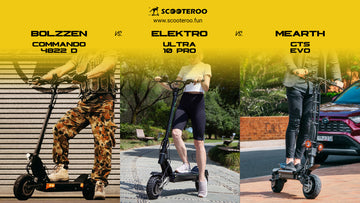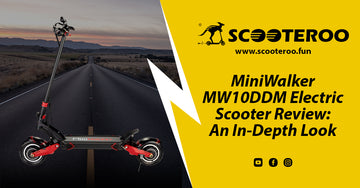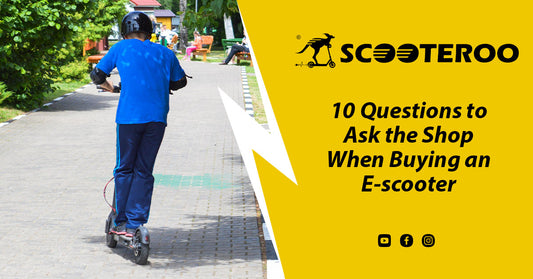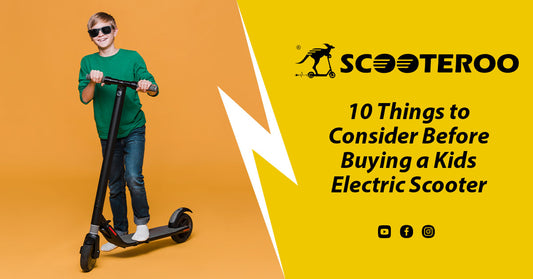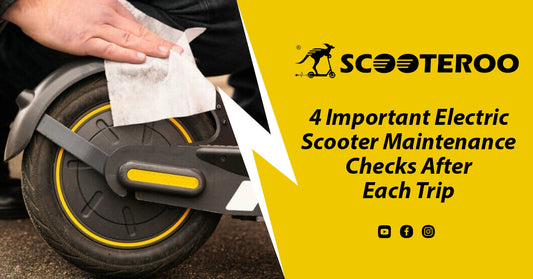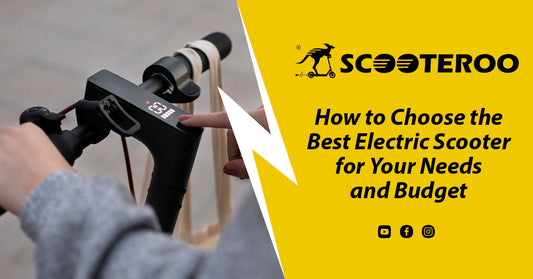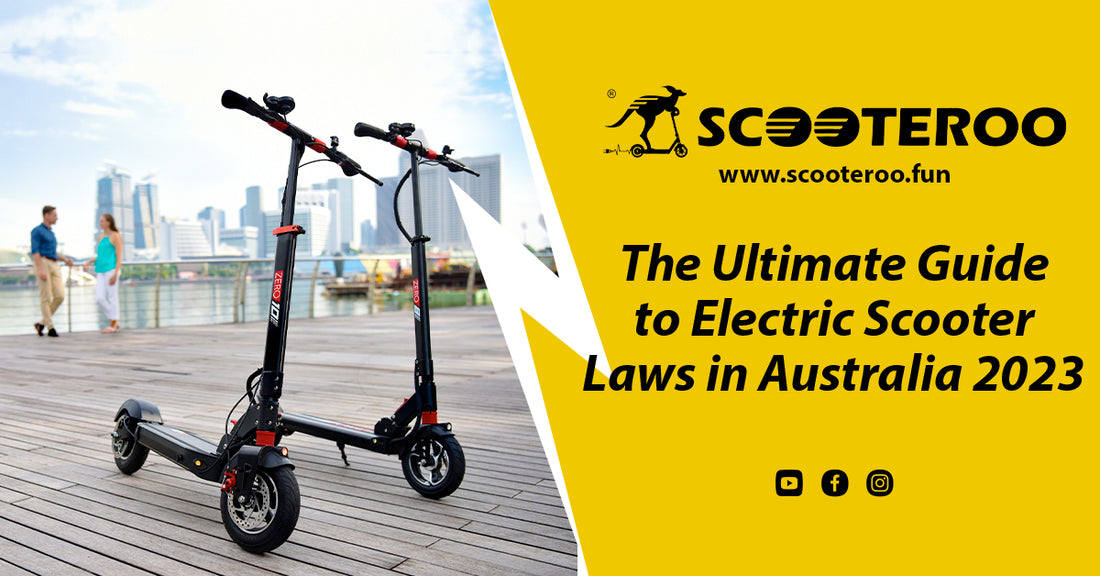
The Ultimate Guide to Electric Scooter Laws in Australia 2023
After a few years of e-scooter trials, many of the electric scooter laws in Australia have already changed, with some allowing private e-scooters in public.
Although most states still struggle with integrating e-scooters into the transport system, current e-scooter laws have helped keep riders efficient and safe on the road.
If you’re using or planning to use an e-scooter for commutes or leisure trips, you should learn your state’s e-scooter laws to keep yourself safe while riding and avoid breaking the law. Note that breaking these laws can result in serious penalties.
So, check your state’s e-scooter laws below!
Australian Capital Territory

The Australian Capital Territory (ACT) made e-scooters, e-skateboards, segway-like devices, and other personal mobility devices (PMD) a legal form of transport on 20 December 2019 through amendments to the Road Transport (Road Rules Regulation 2017.
E-scooter Requirements
E-scooters and other PMDs must meet the following requirements to ride legally in public:
- Uses an electric motor
- Designed for single-person use
- Must not be more than 60 kg unladen
- Includes one or more wheels
- Has a brake system
- Has a top speed of 25 kph on level ground
- Has dimensions not more than 1,250 mm in length, 700 mm in width, and 1,350 mm in height.
You may also ride ACT’s approved shared e-scooters, Beam Mobility and Neuron Mobility.
E-scooter Road Rules and Regulations
If your e-scooter fits the requirements above, you may ride them on footpaths, bicycle paths, shared paths, and the bicycle side of separated paths. You can also use these devices freely on private property.
Riders can’t use e-scooters on roads or separated footpaths unless there’s no footpath or it’s impractical to travel on them.
Other road rules to remember include:
- The top speed on footpaths is 15 kph.
- The top speed of shared paths, bicycle paths, and the bicycle side of separated paths is 25 kph.
- Riders must slow down to 10 kph when nearing or travelling across a crossing.
- Riders must wear helmets and have lights and reflectors for night riding or hazardous weather conditions.
- The e-scooter must have a bell or other warning device.
- Riders must always give way to pedestrians.
- An adult must supervise riders under 12 years old.
- Riders must NOT:
- Drive under the influence of drugs or alcohol.
- Use a mobile phone while riding.
- Carry a passenger.
Since these regulations apply across ACT, they also apply to Canberra electric scooter laws. For more information, check out ACT’s website.
E-scooter Trial
Beam Mobility and Neuron Mobility have operated shared e-scooter schemes since September 2020 in Canberra, Belconnen, Gungahlin, Woden Valley, Weston Creek, Molonglo, and Tuggeranong.
Here’s a map of the shared e-scooter scheme as of 8 December 2022. You can also check the provider’s app to see which areas e-scooters can be used.
ACT e-scooter laws also apply to this shared e-scooter scheme.
New South Wales
Electric scooter laws in New South Wales previously deemed shared and private e-scooters illegal to ride in public.
After years of talks about a trial, the government finally allowed electric scooter shared schemes starting in July 2022.
E-scooter Requirements
Riders may only ride the approved e-scooter provider in trial areas. Private e-scooters are still illegal to ride on NSW roads, trial areas, and related areas; you can only ride them on private property.
E-scooter Road Rules and Regulations
When riding an e-scooter during the trial, electric scooter laws in NSW state that:
- Riders must be at least 16 years old to ride.
- Riders must not ride on roads and footpaths.
- The top speed for shared paths is 10 kph.
- Riders must wear an approved bicycle helmet while riding.
- Riders must use e-scooter lights when riding at night or during bad weather conditions.
- Riders must not ride under the influence of alcohol or drugs. Serious penalties apply when caught.
- Riders must wear bright-coloured clothing so they are more visible to others.
Also, note that you don’t need a driver’s licence to ride an e-scooter in NSW. The law also requires shared e-scooter operators to cover their devices with proper insurance.
For more information, check out NSW’s electric scooter laws.
E-scooter Trial
NSW allowed councils to apply for e-scooter trials for up to 12 months. The first trials ran between July and October 2022 in the Western Sydney Parklands and Australian Botanic Gardens Mount Annan.
After this, the 12-month e-scooter trial in Lake Macquarie started on 5 December 2022. The council approved Beam as their shared e-scooter provider.
Beam e-scooters are available to use in the following Lake Macquarie tracks:
- Fernleigh Track
- Croudace Bay foreshore
- Warners Bay foreshore and up to Glendale
- Toronto foreshore to Fassifern train station.
Northern Territory
The Northern Territory started an e-scooter trial in Darwin last January 2020. The state implemented strict e-scooter laws during the trial.
E-scooter Requirements
NT considers an e-scooter a motorised foot scooter, which is a wheeled reaction device with a motor. Motorised scooters with a motor power of over 200 W are considered motorised vehicles and must be registered and ridden by licensed riders.
However, motorised scooters like e-scooters don’t comply with the safety standards for road vehicles, so they can’t be granted registration and can’t be ridden in public.
That’s why private electric scooters are illegal to ride in NT, and you may only use shared e-scooters approved by the council.
Meanwhile, NT approved Neuron Mobility as its shared e-scooter provider in Darwin.
E-scooter Road Rules and Regulations
The e-scooter trial followed these rules and regulations:
- Riders must be at least 18 years old.
- Riders must wear a securely fitted helmet.
- The speed limit is 15 kph.
- Shared e-scooter were only permitted on footpaths, shared paths, and bicycle lanes.
- Riders must keep left and give way to pedestrians.
- Riders must also have a warning device and lights fitted on the e-scooter.
- Riders must NOT:
- Travel under the influence of alcohol or drugs.
- Carry passengers.
- Use their mobile phone while riding.
- Take their e-scooter on public transport or outside permitted areas.
See NT’s official website for more information.
E-scooter Trial
If you’re in Darwin, you can ride Neuron e-scooters in the following areas:
- Mindil Markets
- Museum and Art Gallery of the Northern Territory (MAGNT)
- Bundilla Beach
- Darwin Ski, Sailing and Trailer Boat Clubs
- Fannie Bay Shops.
However, you can’t ride or park e-scooters in the following areas:
- Inside the George Brown Botanic Gardens
- Inside Mindil Beach during the Sunset Markets
- Smith Street Mall
- Around Parliament House and the Supreme Court
- Mitchell Street between Peel and Knuckey Streets from 7 pm to 6 am
Meanwhile, key e-scooter parking locations include:
- Darwin Waterfront
- Darwin CBD
- Cullen Bay
- Mindil Beach
- Fannie Bay
Check out Darwin’s official website for more details about the trial.
Queensland

Since 1 November 2022, electric scooter laws in Queensland have implemented new rules for riding personal mobility devices, like e-scooters, vehicles, motorcycles and bikes.
E-scooter Requirements
Electric scooter laws in QLD classify e-scooters, e-skateboards, and self-balancing single-wheeled devices as PMDs.
According to the law, a PMD must:
- Be for single use only
- Have fit within the dimensions 1,250 mm (L) x 700 mm (W) x 1,350 mm (H)
- Have a maximum weight of 60 kg
- Use an electric motor
- Have one or more wheels.
Under the new law, PMDs are now classified as vehicles, so PMD raiders must obey and observe most general road rules, similar to bike riders.
E-scooter Road Rules and Regulations
Here are some of the changes under Queensland's new law. These
Regarding speed limits, e-scooters and other PMDs must ride a top speed of:
- 12 kph on footpaths, crossings, and shared paths
- 25 kph on dedicated bike paths, bike lanes, and permitted local roads
- 10 kph on shared zone
They may also ride according to the path’s speed signage.
Meanwhile, e-scooter riders can ride on:
- Footpaths, separated paths, shared paths, bike paths
- Local streets with a 50 kph-speed limit, with no median strip or dividing line, or one-way streets
- Bike lanes on roads with a 50 kph-speed limit
- Bike lanes separate from traffic (e.g. bollards)
Other new general road rules include:
- Riders must use hand signals or indicators when changing direction.
- Riders must not travel more than two abreast, unless overtaking
- Riders must not lead an animal while travelling
- Riders must only tow a trailer if the rider is at least the age of 16. The passenger in the trailer must also be below 10 years of age and must wear a helmet.
In alignment with bike rules, the new rules now allow e-scooters to:
- Use their phone while stationary on a path or nature strip
- Park on a path or nature strip
- Ride on a safety zone near a tram stop
- Ride diagonally across a pedestrian intersection
- Cross the pedestrian side of a separated footpath
Some e-scooter laws remain, such as riding with an approved helmet, not carrying a passenger, and using bells or warning devices to avert danger.
Learn more about the new rules here.
E-scooter Trial
QLDs most recent e-scooter trial is the 12-month trial that rolled out in November 2022 in Bulimba and Hawthorne. This trial enables access to the suburb’s ferry terminals and the streets around Greenslopes, Buranda, and Holland Park West busway stations.
The state has partnered with Lime, Beam, and Neuron for different cities since they launched e-scooter trials in 2018. Some cities operating shared e-scooter schemes include Brisbane, Bundaberg, Townsville, and Rockhampton.
South Australia
Electric scooter laws in South Australia don’t allow e-scooters and other PMDs in public, except for the approved shared e-scooters for their e-scooter trials.
Locals and visitors don’t need a licence to ride a hired e-scooter. Meanwhile, personal e-scooters may only be ridden on private property.
E-scooter Requirements
SA’s laws define e-scooters as two-wheeled devices charged by an electric motor and battery.
As a requirement, these devices must include a braking system, warning device, and lights, especially for night riding. They should also be lightweight and should only carry one person per unit.
The state defines the shared e-scooters as electric personal transporters for the trial. You can only ride the hired e-scooters approved by the council.
E-scooter Road Rules and Regulations
Here’s a detailed list of rules shared e-scooter riders must follow:
- Must be at least 18 years old to ride
- Must wear an approved and fitted bike helmet
- Must travel on footpaths and shared paths unless prohibited
- If road travel is a must, riders must:
- Ride less than 50 m along the road to avoid the obstruction
- Keep to the left
- Obey traffic signals
- Must not ride on a bus lane, bike lane, or road:
- With a dividing line
- With a median strip
- With a 50 kph speed limit
- Must use warning and signals to avert danger
- Must use a white front light, red rear light, and a reflector at the back when riding at night or in hazardous conditions
- Must not go over 15 kph
- Must not ride abreast and carry passengers
- Must not ride intoxicated by alcohol and drugs
- Must not use a phone while riding
- Must not bring e-scooters on public transport
Learn more on SA’s official website.
E-scooter Trial
SA currently runs e-scooter trials with approved shared e-scooter schemes in Adelaide and North Adelaide, along the Coastal Park Trail, Norwood, Payneham and St Peters, and Unley.
The Adelaide e-scooter trial includes the CBD and North Adelaide. Still, riders may not enter the North Adelaide golf courses, The Adelaide Zoo, The Adelaide Botanic Garden, around the Adelaide Oval during major events.
Meanwhile, the Coastal Park Trail’s e-scooter trial is split into northern and southern sections. The council participating in the trial is the City of Charles Sturt, but e-scooters can’t travel between Third Avenue, Semaphore Park, and Terminus Street, Grange. The e-scooters are available daily from 6 am to 9 pm during Central Daylight Savings Time and from 6 am to 6 pm during Central Standard Time.
Within the City of Norwood, Payneham and St Peters, e-scooter riders may ride on footpaths and shared paths. However, riders must observe a 10 kph-speed limit along footpaths adjacent to State Controlled roads, such as Dequetteville Terrace, Hackney Road, and more.
Lastly, the City of Unley also allows e-scooter riders on footpaths and shared paths. However, they must observe a 10 kph speed restriction along footpaths adjacent to State Controlled roads, such as Greenhill Road, Anzac Highway, and more.
Tasmania
Tasmania updated their regulations for PMDs starting 1 December 2021, allowing PMDs to ride on footpaths, bicycle paths, shared paths, and some roads. The law covers private and shared PMDs.
E-scooter Requirements
Tasmania’s law defines PMDs as small, electrically-powered devices for transporting one person over short to medium distances.
A PMD must also have:
- At least one wheel
- Dimensions less than 125 cm (L) x 70 cm (W) x 135 cm (H)
- A max weight of 45 kg
- A speed limit of 25 kph
- A carrying capacity for only one person
Moreover, a PMD includes an e-scooter, e-skateboard, self-balancing and one-wheel devices.
Note that you don’t need a licence to ride e-scooters if they meet the requirements above. Otherwise, the law considers your device a motor vehicle; you must carry a licence and have the device registered.
E-scooter Road Rules and Regulations
These are the e-scooter laws to follow in Tasmania:
- Riders must be at least 16 years of age to ride a PMD.
- Riders under 16 must use a low-powered vehicle that doesn’t exceed 10 kph and 200 W.
- Riders must wear an approved helmet.
- The speed limit on footpaths is 15 kph, while shared paths, bicycle paths, and roads have a speed limit of 25 kph.
- Riders must have a visible white front light, a red rear light, and a red rear reflector on the device when riding at night.
- When sharing footpaths and roads with others, riders must:
- Give way to pedestrians
- Travel a sufficient distance from pedestrians
- Keep to the left
- Be careful, attentive, and considerate.
- Riders must NOT:
- Use a mobile phone while riding
- Be under the influence of drugs or alcohol
- Carry another passenger or animal.
For more information, check out Tasmania’s road safety rules for PMDs.
E-scooter Trial
Tasmania currently has e-scooter trials in Hobart and Launceston.
Hobart’s e-scooter trial with Beam and Neuron will extend until 23 June 2023. You can check the city’s restricted zones and more through this map.
Meanwhile, Launceston’s extended trial ended in March 2023, and the council has yet to announce if there will be an extension.
Victoria

Electric scooter laws in Victoria now allow private e-scooters to join their extended e-scooter trial. This recent law will apply to riders across the state, especially in the cities of Melbourne, Yarra, Port Phillip, and Ballarat.
E-scooter Requirements
Victoria defines a legal e-scooter as a vehicle:
- designed for one person
- Ridden while standing
- With two wheels
- With a footboard between the front and rear wheels
- Steered by a handlebar
- Propelled by one or more electric motors or by foot
- With a top speed of 25 kph
Although private e-scooters are now allowed in the state, personal e-scooters must still comply with these requirements. Otherwise, they’re considered an unregistered motor vehicles and will be subject to penalties.
E-scooter Road Rules and Regulations
The new e-scooter rules in Victoria apply to personal and shared e-scooters. The new law states that riders:
- Must be at least 16 years old
- Must wear a helmet
- Must ride a top speed of 20 kph
- Must travel on shared paths, bicycle lanes, and roads with a 60 kph speed limit
- Must never ride on footpaths
- Must not travel while intoxicated
- Must not use their phones while riding
- Must not carry another passenger or an animal
- Must use warnings to avoid danger
- Must not ride two abreast
- Must give way to pedestrians
- Must ride responsibly
Learn more about the state’s new e-scooter rules via its website.
E-scooter Trial
Victoria extended their e-scooter trial for another six months, ending in September 2023. The cities of Melbourne, Yarra, Port Phillip, and Ballarat all follow the new e-scooter laws. All cities also partnered with Lime and Neuron, except for Ballarat, which only partnered with Neuron.
Note that Ballarat covers 25-sq. km. riding area, including Ballarat North, Ballarat Central, Eureka Golden Point, Lake Wendouree, and Redan.
Western Australia
Electric scooter laws in Western Australia allow e-rideables, such as e-scooter and skateboards, to be ridden in public if they meet the law’s specifications.
The state also recently launched a two-year E-scooter Share Scheme in Perth, partnering with Bird Rides Australia and Neuron Mobility.
E-scooter Requirements
Under the Road Traffic Code 2000, the state considers an e-rideable as an electric rideable device that:
- Includes at least one wheel
- Carries only one person
- Has dimensions of 125cm (L) x 70 cm (W) x 135 cm (H)
- Weighs 25 kg or less
- Travels a top speed of 25 kph
If your device doesn’t meet these rules, you can’t ride them in public.
E-scooter Road Rules and Regulations
Here are the electric scooter laws in WA that riders must follow:
- Riders must be 16 years of age or older.
- Helmets must be worn at all times.
- All e-scooters must have a bell or warning device fitted.
- Riders must use lights and reflectors at night
- Riders must not exceed 10 kph speed limit on footpaths and 25 kph on bike paths, shared paths, and local roads
- Riders must not travel while intoxicated.
- Riders must not use their mobile devices while riding.
- Never carry a passenger or animal while riding.
For more information, check out WA’s website.
E-scooter Trial
The City of Perth started a two-year E-scooter Share Scheme on 18 March 2023. The city partnered with Bird and Neuron, with both brands providing geo-fenced e-scooters to riders.
During the trial, riders will have designated parking spots as a safety measure for pedestrians. Riders are encouraged to download the providers’ app and plan their routes, so they can park responsibly.
The shared e-scooters are available for hire 24/7 in most parts of the city. However, e-scooters can’t enter Northbridge from 9 pm to 6 am on Friday and Saturday nights.
Observe Your State’s E-scooter Laws for Your Safety
Remember that these rules are in place for the safety of riders, pedestrians, and other vehicles. Scooteroo also reminds riders to observe traffic rules and be mindful of others and their surroundings to avoid danger and accidents.
As these e-scooter trials continue to shape electric scooter laws in Australia, commuters should keep updated about the latest news.
To receive recent e-scooter news, related articles, and the latest Scooteroo promos, subscribe to our newsletter below.

